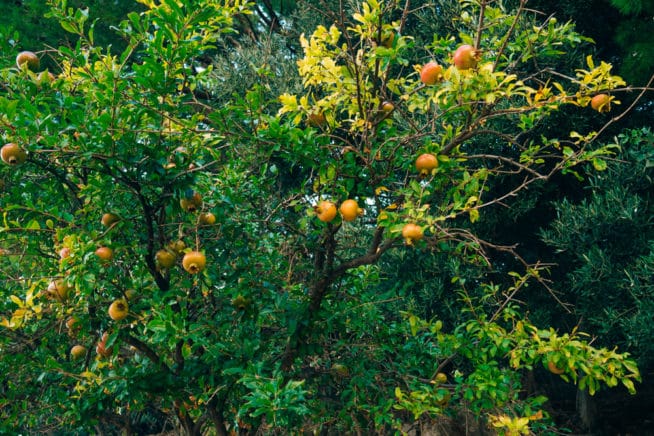The pomegranate is a beautiful, flowering fruit tree that produces delicious red arils. But what exactly does a full-grown pomegranate tree look like? Let’s take a closer look at the distinctive features of this eye-catching plant
Mature Size
A mature pomegranate tree typically reaches 12-20 feet in height with a rounded, spreading shape. The dwarf varieties only grow 3-8 feet tall. The pomegranate is considered a small tree or large shrub.
Leaves
The leaves are glossy and oval-shaped, resembling willow leaves. They emerge bright green in spring and summer. In fall, the leaves turn yellow or red before dropping. The leaves grow alternately along the woody branches.
Flowers
One of the most ornamental features of the pomegranate are the vibrant orange-red flowers. The flowers have tubular, crumpled petals with ruffled edges. They bloom singly or in clusters at the branch tips in spring or early summer.
Fruit
The ripe fruit develops by late summer or early fall. It is round, between 2-5 inches wide, with a thick, leathery skin or rind. The rind is typically yellow overlaid with light pink to deep red. The interior contains many white membrane-covered seeds surrounded by juicy, bright red pulp called arils.
Bark
The trunk and older branches have gray bark with slight fissures or cracks in it, Younger branches are smoother and brownish-gray Spiny thorns occasionally emerge from the branches,
Roots
The pomegranate has an extensive root system. The roots are shallow but wide-spreading.
Ideal Growing Conditions
For optimal growth and fruit production, pomegranates require full sun and hot summers. They thrive in zones 7-10. Pomegranates can tolerate drought but produce the best with weekly watering. Well-drained soil is essential to prevent fungal disease.
Popular Varieties
Some popular pomegranate cultivars include
-
‘Wonderful’ – Large, deep red fruit with sweet, juicy arils. Heavy producing.
-
‘Early Foothill’ – Sweet, soft-seeded fruit that ripens early. Good for cooler climates.
-
‘Granada’ – Sweet, tangy flavor. Produces abundant, medium-sized fruit.
-
‘Parfianka’ – High yields of large, soft-seeded fruit. Ideal for juicing.
Ornamental Value
With its red ruffled blooms, attractive foliage, and showy fruit, the pomegranate tree provides year-round visual interest. It makes a beautiful focal point in the garden or container plant. Dwarf varieties can be grown in pots on patios and decks.
Growing a “Wonderful” Pomegranate Tree // 2-Year Update
FAQ
How long does it take for a pomegranate tree to bear fruit?
Where do pomegranate trees grow best?
What’s the difference between a pomegranate tree and a pomegranate bush?
How big does a pomegranate tree get?
How long does a pomegranate tree take to ripen?
A: Pomegranates ripen 5-7 months after flowering. However, the plant needs to be mature enough to produce. Shrubs and trees usually take at least 2-3 years to come to maturity. Q: Where do pomegranate trees grow best? A: California’s the primary pomegranate-producing state in the US, although most southern states are able to grow them well.
What does a pomegranate tree look like?
A full-grown pomegranate tree is a large shrub or small tree with smooth, glossy green leaves and showy orange-red trumpet-shaped flowers that bloom in the spring. The round red pomegranate fruits between 2 to 5 inches in diameter appear after flowering and ripen in the fall.
How big do pomegranate trees get?
Pomegranate trees range in size from 3 feet to 30 feet, but most grow to be 8-15 feet tall. It’s relatively easy to control the size of a pomegranate tree with regular pruning, but most do grow vigorously. If you have limited space, choose a variety that naturally stays a bit smaller, such as ‘Parfianka’ or ‘Red Silk’.
Can pomegranates grow on a tree?
The arils are tart to sour and the fruits grow on a small-sized tree. It’s a good choice for cooking. Pomegranates do best when they grow in climates USDA hardiness zones 7-12. With a little cover, they can potentially grow down to zone 5. Pomegranate trees need a location with full sunlight.
- A Complete Guide to Caring for Yuki Cherry Blossom Shrub - January 23, 2025
- Identifying Red Hot Poker Seeds: What to Look For When Harvesting Torch Lily Pods - January 23, 2025
- A Complete Guide to Harvesting Evening Primrose Seeds - January 23, 2025

